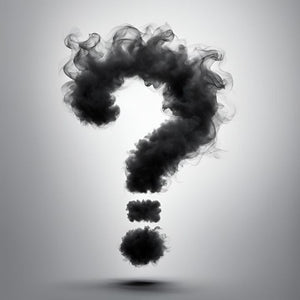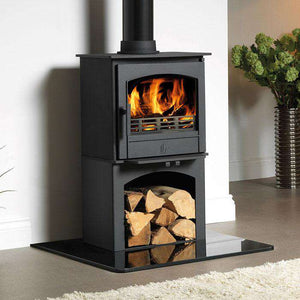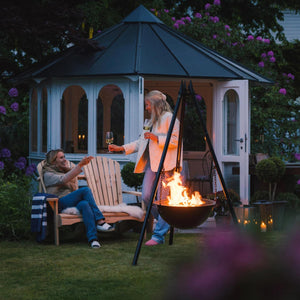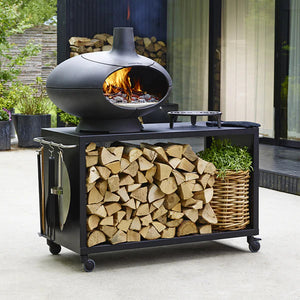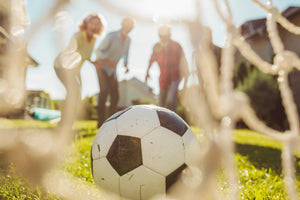What's The Best Wood To Burn In Your Stove?

Content:
----- What is seasoned wood?
----- Why is wet wood so bad?
----- A must have wood burning accessory!
----- Which wood should I burn?
If you fill your car with the wrong fuel, it doesn't work very well.
This same principle applies to the fuel you use in your wood burning stove.
There are many different types of wood out there and they all share one thing in common; they all burn!
However…….
Each type of wood has its own unique properties that affect the way it burns. When selecting your wood, it is important you consider the following features:
- Heat Output – How hot do you want your wood to burn?
- Flame – Do you want a big, medium, or small sized flame?
- Splitting – How easy is your wood to chop?
- Smoke – Usually, the thicker the smoke, the worse it is for your flue system.
- Crackling & Sparking – A wood that sparks a lot can cause excessive deposits on your glass, crazing (scratching) it faster.
The most important factor to remember before burning a log is that you should always use seasoned dry wood!
What is seasoned wood?
‘Seasoning’ is a term given to the process of drying out wood. The lower the moisture content in wood, the better and cleaner it will burn. There are two methods by which timber can be dried...
- Natural Drying (air drying) – The drying of timber by exposing it to the air.
- Artificial Drying – The drying of timber by introducing heat.
‘Natural Drying’ tends to be the most popular choice, as it's a lot less expensive and not everyone has access to the equipment required for kiln drying. It also produces a much higher quality, more easily workable wood. The only drawback to this method is that (depending on your climate) it can take up to several months to a number of years to air dry wood.
Why is wet wood so bad?
Moisture greatly effects the burning process of wood. If for example, a log retaining 50% moisture is burnt at high temperature, about 5% of the logs energy is wasted through evaporating water vapour. This water vapour then condenses on your flue, which will rot your system in no time.
When burning wet wood, you also run the risk of a chimney fire. Unseasoned wood will cause excess smoke and soot (as well as crushing your fire's flame). This excess soot and creosote can get stuck to your flue pipe & liner; and due to high burning temperatures, can combust, causing a fire.
If your appliance makes use of an airwash system, wood with a high moisture content significantly reduces its effect, causing excess emissions to stain and craze the glass.
In short, just don’t use wet wood. Ever. It’s just not worth it.
A must have wood burning accessory!

A moisture meter is the most important woodburners tool for ensuring that your wood is ready for burning. Many shop outlets claim to sell ‘seasoned wood’ but in some cases, their moisture content is still far too high. If firewood is well seasoned, it should have a moisture content of 20% or lower. These meters will display the water % by simply pushing the two pins into your chosen piece of firewood. A quick and effective way of making sure your wood is ready to burn.
Which wood should I burn?
We have compiled a list of the most common types of wood you might come across. Each one displays a rating based on its overall performance to help you choose the best fuel for your appliance.

Alder - Rating: 2 / 5
Although classified as a hardwood, Alder's one of the softest of all the hardwoods and is more commonly referred to as a semi-hardwood. Seasoned Alder firewood burns relatively fast and produces very little heat.

Apple - Rating: 4 / 5
Best known for its cooking qualities, Apple can be a very expensive endeavour for constant wood burning. Burns slow and steady and emits a mild/sweet aroma. Has a small sized flame with minimal sparking, moderate in heat output.

Ash - Rating: 5 / 5 *highly recommended*
Widely regarded as the best wood to use, Ash is known for its easy splitting and low moisture content. With a fantastic heat output, slow burn, excellent flame, and reasonably priced. We highly recommend using Ash as your main source of firewood.

Beech - Rating: 5 / 5
Easily identified by its unique smooth silver bark, this dense hardwood burns hot and clean with very minimal sparking. Slightly higher on its moisture content, it can take longer to season than other woods.

Birch - Rating: 4 / 5
Black, Yellow or White. Birch can burn from excellent to just OK. It produces a good heat output of around 250-300 degrees. However, it produces a large amount of excess creosote that can block flues with prolonged use.

Cedar - Rating: 4 / 5
Ideal for kindling, this porous lightweight wood has an above average oil content, creating a hot and fast burning fire. This also causes the wood to crackle and spark frequently, resulting in excess deposits that can form on your glass and flue. Cedar wood produces a small flame.

Cherry - Rating: 4 / 5
Known for its lovely aroma when burnt, Cherry is easy to split and supplies a moderate heat output in comparison to superior firewood. Sparking more than other hardwoods, it produces a moderate sized flame.

Chestnut - Rating: 1 / 5
Splits terribly. Moderate density. Needs two years to season. Small flame. Poor heat output. Need I say more? Chestnut is one of the worst woods for burning. Avoid burning Chestnut.

Douglas Fir - Rating: 3 / 5
A popular softwood among wood burners, with mixed reviews. Requires around a year to season and is among the easiest to split. Douglar Fir creates a lot of smoke and soot, potentially resulting in excess deposit build up. Moderate in heat output and a small flame.

Elder - Rating: 2 / 5
Burns very quickly with very low heat output. Produces thick smoke. Folklore writes that witches were fond of turning themselves into Elder trees and burning them can invite death..... your choice!

Elm - Rating: 3 / 5
Due to its high moisture content, it is advised to use other woods when first starting your fire. Elm is perfect for putting on the last thing at night as it burns so slowly. It is advised to let season for 2 years before burning and to split earlier rather than later.

Eucalyptus - Rating: 1 / 5
Burns fast with a fresh medicinal smell. Eucalyptus wood is full of sap and oils when fresh, that can very easily cause a chimney fire if burned unseasoned. Hard to split with a mediocre heat output.

Hawthorn - Rating: 5 / 5
Can be difficult to come across, however a fantastic firewood. Hawthorn burns very slowly with exceptional heat output. It can be hazardous to handle un-split due to its fierce thorns.

Hazel - Rating: 4 / 5
An excellent fast burning wood. Hazel tends to burn up faster than most other hardwoods. Emits a good amount of heat with a decent sized flame. For the best results allow to season.

Holly - Rating: 1 / 5
Holly produces a very bright flame but that's pretty much it. It is a fast burning hardwood that emits very little heat. Suitable for burning while still green, but for best results allow to dry for a minimum of one year.

Hornbeam - Rating: 4 / 5
Native to the south of the UK, Hornbeam firewood burns very similar to Beech. It gives off a great amount of heat and burns slowly. It's name comes from the hardness of its timber - 'horn' meaning 'hard' and 'beam' being the name for a tree in old English.

Horse Chestnut - Rating: 3 / 5
Classed as a low-quality firewood, Horse Chestnut produces a good flame and heat output. The downside to this firewood is its tendency to crackle and spit a lot. Not recommended for open fires, but suitable for stove use.

Laburnum - Rating: 0 / 5 *NEVER USE*
An absolute never use. The tree is completely poisonous and emits a massive amount of foul smelling smoke when burned. This will render your flue and airwash systems obsolete. We strongly advise against ever burning this wood.

Larch - Rating: 3 / 5
A nice scented hardwood when burnt, Larch is a very crackly firewood. It emits a good amount of heat however, it needs to be well seasoned. The oil and sap emitted when burning can clog up flue systems very fast if used regularly.

Laurel - Rating: 3 / 5
Produces a fantastic flame when burnt, but very mediocre with its heat output. It is recommended that you season laurel well. Questions have been asked about cyanide being emitted when burning. The amount would be so minuscule that you would not be effected unless you stuck your head in the smoke for 5 minutes. If you did do that though, the carbon monoxide would get you first.

Lilac - Rating: 4 / 5
It's thinner branches are ideal for use as kindling, whilst the main bulk of the log produces a clear flame and a very pleasant floral smell. Make sure you allow it to dry for several months before burning.

Lime - Rating: 1 / 5
Mainly used as a carving material for sculptors, this hardwood is a low-quality fuel. It produces a very dull flame along with an equally dull heat output. If you have a few carving scraps left over then throw them on the fire, otherwise stay away.

Maple - Rating: 4 / 5
Known primarily for its sugar production, Maple produces a very hot fire. It is perfect for use in a fireplace or wood furnace. The wood is difficult to split but is worth the effort as you will be rewarded with a magnificent full flame.

Oak - Rating: 4 / 5
Must be seasoned for two years or you will be stuck with a very sporadic flame and acrid smoke. Once seasoned, dry Oak is absolutely excellent for heat. Due to its density it produces a small flame and burns very slowly, eventually collapsing into a powder-like ash.

Pear - Rating: 4 / 5
Very similar to Apple, Pear burns slowly and provides a decent amount of heat output. With its own sweet smell, its flame is a little lack luster. It does require very good seasoning before burning.

Pine (general) - Rating: 3 / 5
The general Pine family (including Leylandii) burns with a great flame, but has a tendency to split frequently. Full of sap and oil, Pine has a tendency to emit deposits on the flue and glass when burned. To best avoid this, make sure it is properly seasoned.

Plane - Rating: 3 / 5
Similar in colour and appearance to maple, Plane burns fairly pleasantly. It has a moderate flame and heat output. Do no use on open fires as it has a tendency to throw out a lot of sparks.

Plum - Rating: 4 / 5
Another fine smelling wood, it provides a moderate heat output with a small to medium sized flame. A popular choice among open fire chefs, great choice for cooking.

Poplar - Rating: 1 / 5
Defiantly not recommended. Poplar is a terrible fuel that doesn't burn well. It produces a thick black choking smoke that clogs chimneys, even when seasoned well.

Rowan - Rating: 5 / 5
A very dense wood that burns slow with excellent heat output. The flame is medium to large with minimal sparks and crackling. All together, an ideal all round firewood.

Rhododendron - Rating: 4 / 5
The older the better. The thick stems of Rhododendron burn long and hot. Sparking is minimal in this wood so it is ideal for both open and contained fires. Make sure your wood is as dry as possible to avoid excess soot and other deposits, as un-seasoned Rhododendron is one of the worst.

Robinia (Acacia) - Rating: 4 / 5
An extremely hard wood. Due to it knots it can be prone to splitting when seasoning. Robinia burns slowly with a great amount of heat output, but the flame size is barley visible. It produces a very acrid and dense smoke, so we only recommend this wood for stove use.

Spruce - Rating: 2 / 5
This soft wood burns incredibly fast, you will go through so much of it that it's false economy to use as your main source of fuel. The heat output is terrible and it produces an outstanding amount of sparks, a no go for open fires.

Sweet Chestnut - Rating: 3 / 5
A slightly disappointing firewood. Sweet Chestnut is prone to splitting, and splitting, and splitting. When seasoned well it burns 'ok' but is nothing special. Use if you have some spare, but there are better alternatives out there.

Sycamore - Rating: 3 / 5
Burns with a great flame and emits a moderate heat output. Out of all the woods, the results of Sycamore depend massively on its seasoning. If burnt 'green', its arguable one of the worst. If seasoned well it holds it's own.

Thorn - Rating: 5 / 5
A fantastic firewood. It burns slowly and gives out great heat. There is very little smoke and soot emitted when burning, it might be one of the cleanest to use. To top it all off, the flame is steady and strong, perfect for viewing.

Walnut - Rating: 3 / 5
With medium density, Walnut is relatively easy to burn. It burns clean and is very easy to get going. Its heat output isn't great when compared to hard woods such as Oak, but fairs much better than softwoods like Pine or Fur. Emits a nice aromatic scent.

Wellingtonia (Giant Sequoia) - Rating: 2 / 5
These gigantic redwood trees are the largest single trees in the world. Unfortunately their burning quality doesn't match their impressive stature. The heat output is very poor and it doesn't last very long, leave these ones in the ground.

Willow - Rating: 2 / 5
Even when seasoned very well, Willow is a poor firewood. It burns slowly with a very small flame. It emits low heat and is very prone to constant sparking. Make sure not to call this wood peck!

Yew - Rating: 5 / 5
The wood burns slowly with fierce heat when seasoned well. Yew also emits a very pleasant scent. This is a highly recommended choice of firewood, you can also use a few leftover scraps for carving.
- Matthew Wigglesworth


